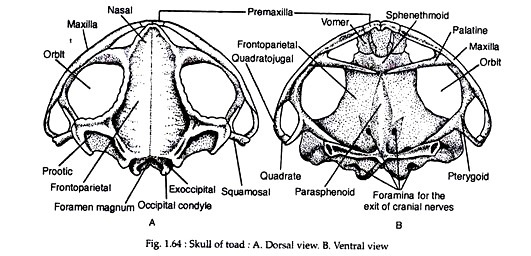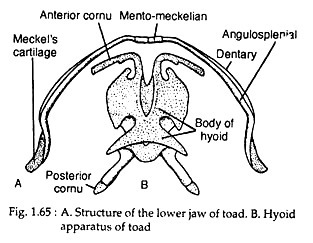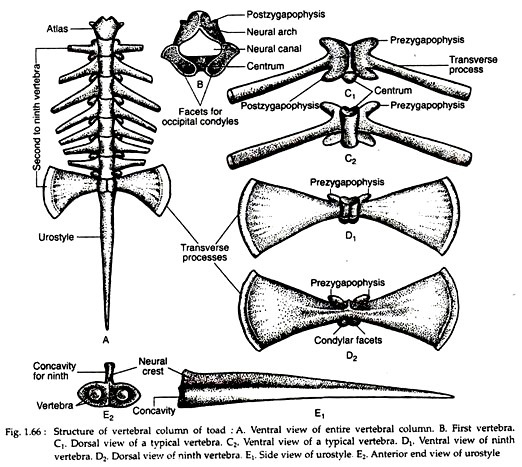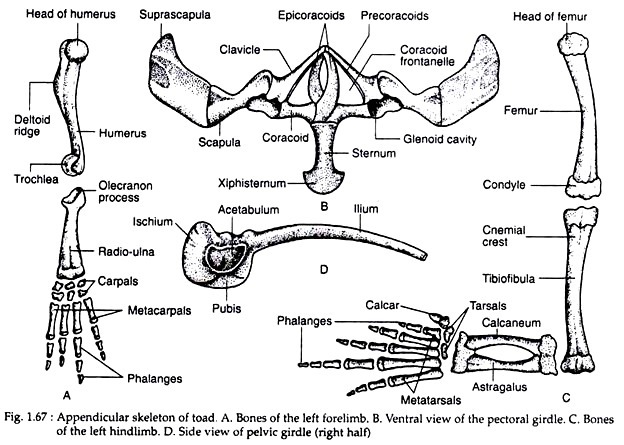In this article we will discuss about the skeletal structure of toad.
There is no exoskeleton in toad. The skeleton that supports the soft parts lies internally and is designated as endoskeleton. It is chiefly made up of bones and cartilages. These two structures are associated with one another to form the internal framework.
The endoskeleton is described under two broad heads:
(1) The axial skeleton, and
ADVERTISEMENTS:
(2) The appendicular skeleton.
(1) Axial Skeleton:
The axial skeleton comprises of the skull and the vertebral column.
(i) Skull:
ADVERTISEMENTS:
The skull of toad (Fig.1.64) is flat and broad. It contains a tubular cranium and is pierced posteriorly by a large aperture called foramen magnum. Through this aperture the spinal cord passes. On each side of this foramen there is an exoccipital bone which bears a convex occipital condyle.
So there are two occipital condyles which fit into the two concavities of the first vertebra. The occipital condyles are developed from the exoccipitals. The roof of the cranium is made up of two flat bones called the frontoparietals. Each frontoparietal is formed by the fusion of two bones, the frontal and parietal (Fig. 1.64A).
The floor of the skull is formed of a dagger-like Para sphenoid (Fig. 1.64B). A ring-like sphenethmoid bone is present at the anterior end of the cranium. This bone is completely covered by frontoparietals on the dorsal side. The nose is covered dorsally by a triangular nasal bone and the floor is provided with the vomer (Fig. 1.64B).
ADVERTISEMENTS:
The cartilaginous otic capsules are loosely attached with the cranium. The auditory capsules are situated in front of the exoccipitals. The floor of the auditory capsule is supported by the lateral extension of the Para sphenoid and the dorsal side is covered by prootic bone. A small hammer-like squamosal connects the posterior part of the upper jaw with the otic capsule.
Each half of the upper jaw is made up of small premaxilla, long slender maxilla and quadratojugal. Behind the quadratojugal there is a very small Y-shaped supporting bone called the quadrate. The other two supporting bones are the pterygoid and the palatine. The palatine is rod-like and connects the maxilla with the sphenethmoid bone.
The lower jaw is composed of two halves and the halves are united anteriorly by ligament (Fig. 1.65A). Each half is developed from a Meckel’s cartilage and consists of three bones, the dentary, angulosplenial and mentomeckelian. The posterior part of the angulosplenial articulates with the upper jaw. Both the upper and lower jaws are toothless in toad.
Hyoid apparatus:
The hyoid apparatus is essentially a cartilaginous structure which supports the floor of the buccal cavity (Fig. 1.65B). It also forms the supporting framework for the attachment of the tongue. The body of the hyoid constitutes the main bulk of the apparatus.
There are two pairs of prolongations (or horns) from the body of hyoid apparatus. The anterior pair are longer and extend up to the auditory capsules. These are called anterior cornu. Similar pair on the posterior side are known as posterior cornu which enclose the laryngotracheal chamber.
(ii) Vertebral column:
The vertebral column (Fig. 1.66A) is composed of nine vertebrae and a terminal rod-like structure called urostyle (oura=tail and style=rod).
First Vertebra or Atlas:
It articulates with the occipital condyles of the skull. It is ring-like in appearance (Fig. 1.67B). The transverse processes and the prezygapophyses are absent. Anteriorly it possesses two concave facets which fit with the paired occipital condyles of the skull. The centrum is greatly reduced.
Typical vertebra:
A typical vertebra has a solid cylindrical part known as centrum. The centrum is procoelous, (Figs. 1.66C1, C2). On the dorsal side, the centrum bears a ring-like neural arch which encloses the neural canal. The roof of the neural arch possesses a median elevation known as neural spine. The lateral side of the neural arch carries transverse processes.
The articulating processes are present on the neural arch. The anterior pair of processes are known as prezygapophyses and the posterior pair are called post-zygapophyses (singular—post-zygapophysis). All the vertebrae excepting the first and the last one have typical structural construction.
Ninth Vertebra:
This vertebra is peculiar and has two-rounded condyles on the posterior side of the centrum for articulation with the anterior paired concavities of the urostyle. The transverse processes are stout, fan-shaped (Fig. 1.66D1, D2) and articulates with the pelvic girdle. The postzygapophyses are absent. The ninth vertebra is also known as sacral vertebra.
Urostyle:
The urostyle is a long slender rod-like structure (Fig. 1.66E1, E2) and is formed by the fusion of a number of vertebrae. It has a pair of concave cavities at its anterior end for articulating with the paired posterior convexities of the ninth vertebra. It has a mid-dorsal neural crest.
A very narrow hole is present throughout the urostyle which represents the reduced neural canal. Through this canal passes the filum terminale of the spinal cord.
(2) Appendicular Skeleton:
The skeletal frame of the paired limbs and the girdles constitute the appendicular skeleton (Fig. 1.67).
(i) Pectoral girdle:
The pectoral girdle consists of two symmetrical halves. These halves are united at the mid-ventral line but are free dorsally (Fig. 1.67B). This girdle forms a bony framework for encircling the anterior part of the trunk. Each half of the pectoral girdle is made up of a broad dorsally placed and partly cartilaginous plate like structure known as suprascapula.
Attached to it, there is a strong bone called scapula. Two rod-like bones are connected with the scapula. The anterior one is called clavicle, while the posterior one is known as coracoid. The clavicle encloses the precoracoid cartilage which is hardly visible. The clavicle and the coracoid are joined with partly overlapping pieces, the epicoracoids.
The space present between these three bones is designated as coracoid frontanella. Just at the junction of the clavicle, coracoid and scapula there is a cup shaped depression called glenoid cavity into which the head of humerus fits. Projecting posteriorly from the united posterior end of the epicoracoid there lies a sternum which has a terminal flattened cartilaginous xiphisternum.
(ii) Pelvic girdle:
The pelvic girdle is a V-shaped bony structure having a disc-like posterior end. The disc is formed by the union of three bony units on each side, the ilium, ischium and pubis (Fig. 1.67D). A cavity known as acetabulum is present on each side of the disc. The head of femur fits into this cavity.
The ilia are elongated curved rod-like structures which are attached with the transverse processes of ninth vertebra. They form the anterior and dorsal sectors of the disc. Two pubes (singular—pubis) are represented by a triangular cartilage on the ventral side of the disc. The posterior sectors of the disc are formed by the ischium.
(iii) Forelimbs:
There are two forelimbs and each forelimb is composed of several long bones arranged end to end (Fig. 1.67A). The first one in the series is called humerus whose middle region is slightly curved. The proximal end is termed as the head of the humerus which fits with the glenoid cavity of the pectoral girdle.
The distal end carries a pulley-like trochlea. A prominent crest called deltoid ridge is extended from the head to the middle region of the humerus. The second in the series is the radio-ulna formed by the fusion of two separate bones, radius and ulna. The anterior end of the radio-ulna is concave and fits with the trochlea of the humerus.
The proximal end is drawn out into an olecranon process. The distal end is flattened to give attachment of six carpal bones which are arranged in two rows. Four slender rod-like bones called metacarpals are connected with the digits. There are four digits. The third and fourth digits have three phalanges and the first and second have two phalanges.
(iv) Hind limbs:
The hind limbs, like the forelimbs, are also paired structures. Each is made up of series of long bones (Fig. 1.67C), The proximal one is the femur which is gently curved. The anterior end of the femur is rounded to form the head of the femur which fits with the acetabulum of the pelvic girdle. The posterior end of femur is slightly flattened to form the condyle.
The next part is known as tibiofibula formed by the fusion of two bones, the tibia and fibula. Both the ends of the tibiofibula are expanded to give articulation with the condyle of the femur anteriorly and with the tarsal bones distally. The tarsal bones are arranged in two rows. The proximal tarsals are the astragalus and calcaneum.
These are elongated structures and are slightly curved outward. Both the astraglaus and calcaneum are joined with one another at both ends. The distal tarsals are composed of two or three small bones. The foot is constituted of five metatarsals. There are five digits having variable number of phalanges.
The first and second digits have two phalanges, the third and fourth have four phalanges and in the fifth there are three phalanges. A bony projection made up usually of two small bony nodules is present on the outer side of the hallux. This structure is known as the pre-hallux or calcar.



